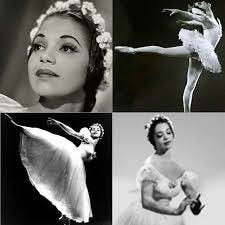Issue #846 Today In Black History, Wednesday, April 23, 2025
If you like us, REALLY like us, please click the little heart “Like” button at the top of this post!
Your “Likes” mean a LOT to us! We appreciate your support!
Engage with us and our posts in Substack Notes, where we post almost daily.
Our April 2025 subscriber goals are 200 new free subscribers and 100 new paid subscribers! You can help us reach our goal!
Follow Pam on Bluesky, the best “X” alternative.
Follow Keith on Bluesky, the best “X alternative.
Independent Authors and Creative Professionals: books and courses on Branding and Marketing just for you via Pam Speaks 2 You.
We appreciate your support!
Born on March 2, 1917, in New Orleans, Louisiana, Janet Collins showed an early aptitude for dance. After her family moved to Los Angeles, she developed her talents in both dance and art, studying ballet, modern dance, and ethnic dances, as well as drawing and painting.
In 1932, at the age of 16, Collins auditioned successfully for the prestigious Ballet Russe de Monte Carlo. However, as she was required to paint her face and skin white to perform, she did not join the company.
In 1951, she made history when she became the first African American prima ballerina at the Metropolitan Opera in New York City. Despite her success in New York, Collins faced racism on the road as the company toured to southern cities. As race laws kept her off the stage, understudies sometimes performed her parts, and her unrelenting perseverance in the face of such stringent racial barriers was incredibly courageous. Ms. Collins remained with the Met until 1954.
Janet Collins performed on Broadway, in films, and appeared frequently on television. She was among the pioneers of Black ballet dancing and one of her generation’s few classically trained Black dancers.
Her debut performance as Princess in the opera Aida was a landmark moment for her career and Black classical ballet artists. Her presence on such a prestigious stage opened doors for other artists of color.
In 1974, Collins retired from performing and teaching, devoting herself to her Catholic religion and finding comfort as an oblate in the Benedictine Order. She was also an accomplished painter.
Known for her elegance and emotive style, Janet Collins brought a unique blend of classical technique and personal expression to her performances. Her performances were characterized by a deep understanding of the music and choreography, making her not just a dancer but a master storyteller on stage.
Collins was also an innovator who sought to expand the boundaries of ballet. She choreographed her works, incorporating diverse movements and themes that reflected her cultural heritage and personal experiences.
Collins received a Candace Award from the National Coalition of 100 Black Women in 1989. In 2007, in recognition of Collins' great work and dedication, her renowned cousin Carmen De Lavallade established the Janet Collins Fellowship to honor aspiring talented ballet dancers.
Janet Collins died in 2003 at the age of 86 in Fort Worth, Texas.
Today In Black History
In 1872, Charlotte E. Ray, a graduate of Howard University Law School, became the first female African American lawyer.
In 1913, the National Urban League was founded.
In 1955, the U.S. Supreme Court refused to review a lower court decision that would ban segregation in intrastate bus travel.
In 2015, Loretta Lynch was confirmed by the U.S. Senate to become the first African American woman to serve as U.S. Attorney General, succeeding Eric Holder, who was the first African American to hold the position.
All “We Are Speaking” posts are now free for everyone to read, and commenting on our posts is now open to everyone!
Share this post:
Share this publication:
Our subscriber goals for April 2025 include 200 new free subscribers and 100 new paid subscribers. Click the link to help us reach our goals!
Our paid subscribers are encouraged to discuss this post in our W.A.S. Chat Community.
Join Pamela Hilliard Owens’s subscriber chat
Available in the Substack app and on the web
You are also welcome to view “We Are Speaking” in Substack Notes. You can also read other Substack publications without subscribing to them when you join Notes.
Did you know that you can listen to each “We Are Speaking” post and engage directly with us on the Substack App? Download the app!
Please check out Keith’s AfroFantasy Detroit Substack for posts about fantasy, sci-fi, and Afrofuturism!








